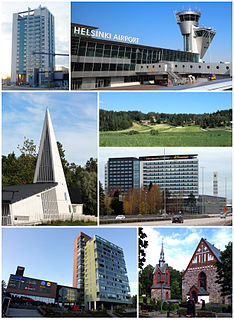
Vantaa is a city and municipality in Finland. It is part of the inner core of the Finnish Capital Region along with Helsinki, Espoo, and Kauniainen. With a population of 235,911, Vantaa is the fourth most populated city in Finland after Helsinki, Espoo and Tampere. Its administrative center is the Tikkurila district.
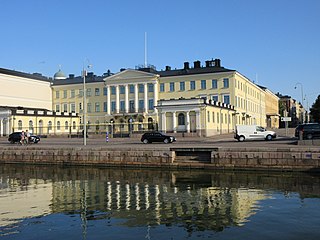
The Presidential Palace is one of the three official residences of the President of the Republic of Finland. It is situated in Helsinki, on the north side of Esplanadi, overlooking Market Square.

The Finnish national road 1 is the main route between the major cities of Helsinki and Turku in southern Finland. It runs from Munkkiniemi in Helsinki to the VI District of Turku, and is part of the European route E18. The road is a motorway for its whole length.

East Helsinki is an area in Helsinki, Finland, usually thought to comprise the city's eastern and south-eastern major districts, including the districts of Vartiokylä, Myllypuro, Mellunkylä, Vuosaari, Herttoniemi, Laajasalo and Kulosaari. With the exception of Kulosaari, the buildings in the area are relatively new – most have been built in the 1960s or later – and constitute relatively densely inhabited suburbs, except for the southern part of Laajasalo and most of Kulosaari. On the other side of the bridge to the west of Kulosaari is Helsinki Downtown, the so-called "West Helsinki". The most important road connection to the city central from East Helsinki with car or bus runs along Itäväylä.
The city of Helsinki, the capital of Finland, can be divided into various sorts of subdivisions. Helsinki is divided into three major areas: Helsinki Downtown, North Helsinki and East Helsinki. The subdivisions include neighbourhoods, districts, major districts and postal code areas. The plethora of different official ways to divide the city is a source of some confusion to the inhabitants, as different kinds of subdivisions often share similar or identical names.
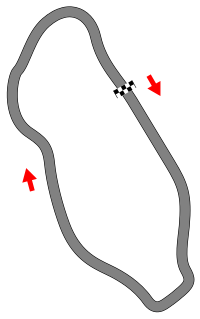
Eläintarhan ajot or Suomen Suurajot as it was called in 1932 was a motor racing competition arranged between years 1932 and 1963 in Eläintarha, Helsinki, Finland. The idea for the race came from a racing driver, S. P. J. Keinänen. Its racing history included the pre-war Finnish Grand Prix.

Munkkiniemi is a neighbourhood in Helsinki. Subdivisions within the district are Vanha Munkkiniemi, Kuusisaari, Lehtisaari, Munkkivuori, Niemenmäki and Talinranta.

Pikku Huopalahti is a neighbourhood in the West of Helsinki between the Ruskeasuo neighbourhood and Mannerheimintie in the east, the Meilahti neighborhood in the South, the Niemenmäki neighborhood and Huopalahdentie street in the West and the Vihdintie street and Etelä-Haaga neighborhood in the North.
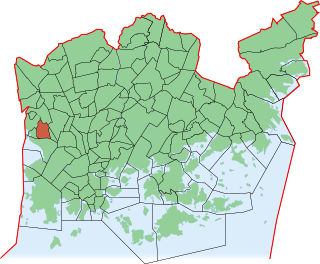
Munkkivuori is a quarter of the Munkkiniemi neighbourhood in Helsinki. The buildings and the plan of site are typical of the late 1950s. Most of the residential buildings in Munkkivuori are within a loop formed by Ulvilantie ring road. The automotive traffic to the residential buildings is routed along Ulvilantie whereas Raumantie no through road terminating in the center of the Ulvilantie loop provides access to public services and limits the through-traffic in residential areas. A designed network of crushed stone walkways provides easy accessibility around Munkkivuori for cyclists, pedestrians and other non-automotive traffic.

Niemenmäki is a quarter of the Munkkiniemi neighbourhood in Helsinki. Niemenmäki was constructed in the early 1960s. The nearby Shopping center provides everyday services to Niemenmäki inhabitants. Huopalahdentie road separates Niemenmäki from Munkkivuori in the West and Lapinmäentie road from Haaga in the North. Allotment gardens separate Niemenmäki both from Pikku Huopalahti in the East and from Vanha Munkkiniemi in the South.
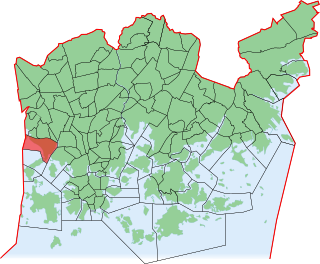
Vanha Munkkiniemi (Finnish), Gamla Munksnäs (Swedish), both of them meaning ′Old Munkkiniemi′, is a neighborhood that contains the original part of Munkkiniemi district in Helsinki, Finland.

Linjat (Finnish), Linjerna (Swedish) is a neighborhood of the Kallio district of Helsinki, Finland. Its name literally means "The Lines" and comes from the five parallel streets named 1st, 2nd, 3rd, 4th and 5th Line, which start at Hämeentie and run north-west, except for the much shorter Ensimmäinen linja, which starts at the southern end of Suonionkatu. The district lies to the north of Hakaniemi and Siltasaari and to the south of Alppiharju.
Huopalahti was a municipality during the years 1920–1945 in Uusimaa, Finland. The municipality was bilingual.
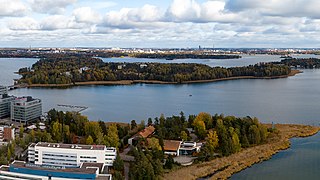
Lehtisaari is an island and part of Munkkiniemi, a neighborhood in western Helsinki, Finland.

The Russian Orthodox Church in Finland is a semi-autonomous part of the Russian Orthodox Church formed in 1926. An official headquarters of the Moscow Patriarchate, led by Father Viktor Lyutik, was opened in Helsinki in 1999.

The Aalto House, the home of Academician Alvar Aalto is located in Munkkiniemi, Helsinki, at 20, Riihitie. The house is part of the Alvar Aalto Museum, which functions in two cities, Jyväskylä and Helsinki. The other location in Helsinki where the museum functions is Studio Aalto, which is located ca. 450 metres from the house, at Tiilimäki 20.
Torpan Pojat, shortened to ToPo, is a basketball club based in Helsinki, Finland. Torpan Pojat has their men's and women's team playing in national 1st division and many minor and junior teams in different age categories.

Helsinki is Finland's only remaining city with tram traffic. Two other cities—Turku (see Turku tram) and Vyborg —have had tram systems. Vyborg abandoned its trams in 1957 after it was ceded to the Soviet Union after the end of World War II. Turku withdrew its trams in 1972.
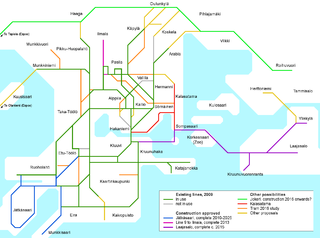
The city of Helsinki has plans for a radical expansion of the tram network within the 2021–2035 time horizon, as laid out in the Helsinki City Plan, approved by the City Council in October 2016. Below is a list of confirmed and proposed future expansions of the network. The largest confirmed projects are the 25-kilometre (16 mi) trunk line 550 ("Jokeri") and the 10-kilometre (6.2 mi) connection in the direction of East Helsinki to the island of Laajasalo, which will include the longest bridge in Finland. Together, these two will effectively double the track length of the network.

The Munkkiniemi Pension or the Munkkiniemi Boarding House is a building in Munkkiniemi, Helsinki, designed by Eliel Saarinen, which was completed in 1918 and located at Hollantilaisentie 11. Saarinen designed the building as well as its interiors. Along with the terraced houses on the other side of the street, the building represents the only concrete commission that resulted from Saarinen's Munkkiniemi-Haaga Plan of 1915.


















